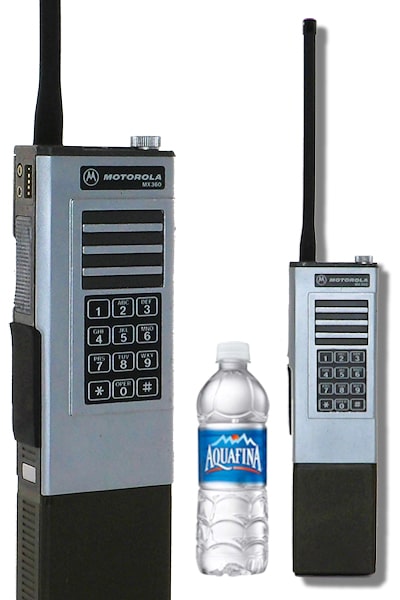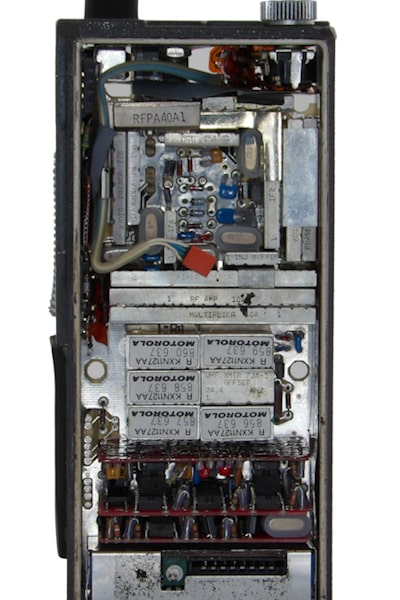Motorola Radios – from yesterday to today
A Look at How Motorola Radios Have Evolved
Motorola has been a leader in two-way radio technology for over 100 years, and their radios have changed significantly over that time. If you're looking to purchase a new two-way radio, you may be wondering how the modern models compare to the radios of yesteryear. Let’s take a look at how Motorola radios have evolved and what they offer today.
Yesterday's Radios

Motorola's first two-way radios were quite large and bulky, with no modern features or conveniences. They were often used by militaries and law enforcement agencies because of their reliable communication capabilities. However, these radios had limited range and no encryption options, so they weren't suitable for all applications.
Back in the 1930s, when two-way radios first came into use, they were large and bulky (Motorola Field Dispatch Unit being an example) weighing over 50 pounds (22.68 kg)! These early versions of two-way radio technology could only be used to communicate between two people who were in close proximity to each other— within a mile or so. With this limited range, these early devices weren’t suitable for widespread use.
Today's Radios
Today’s Motorola radios offer much more than their predecessors did. Thanks to advances in radio technology and miniaturization of components, today’s two-way radio devices are much smaller yet still capable of providing reliable communication across long distances—up to several miles away! This makes them ideal for use by businesses that need reliable communication between multiple locations, or even by individuals looking for an easy way to stay connected on the go. Furthermore, today’s Motorola radios also feature a variety of additional features such as GPS tracking and Bluetooth functionality, which can provide added convenience for users.
Changing or adding a channel could take up to 12 weeks or longer
Not even 40 years ago, two-way radios relied on crystals for their frequencies, for both receive and transmit. These crystals had to be cut precisely to the frequency required by the individual. It could take weeks, if not months, for crystals to arrive, and then a technician was required to disassemble the radio and insert the new crystals.

A technician then needed to fine-tune both the transmit and receive crystals for maximum efficiency. In the event the crystal was cut incorrectly, additional time would be needed to order new crystals. Heavens forbid, if you were to drop the radio hard enough, the crystals inside could shatter or crack. Making the radio completely unusable. Even the PL codes required crystals, no DPL codes back then.
Let’s do the math on a 5-channel radio:
- 5 x Transmit & Receive crystals
- 1 x Oscillator crystal
Note: Crystals weren’t cheap, about $100 to $250 per crystal back then
Today, one connects the radio to a computer and through software, changing the channel or a private code could take less than 5 seconds. Adding a new channel is just as easy. Moving channels around today is a piece of cake, in the past, it would require a technician to open up the radio and move crystals around, and hit you with at least, a $350 repair bill – that’s per radio, by the way.
Pictured on the left is a Working Motorola MX360 2-Way radio in our shop, 5-channel trunked, with many crystals inside. The radio weighs over 2 pounds (0.91 kg) and it’s over 18 inches (ca. 46 cm) long with an antenna. This type of radio was extremely popular with law enforcement because it also served as a nightstick because of its all-metal housing.
It's worth noting that the radio pictured above has a standard Motorola-issued battery, there is an upgraded battery that is two inches longer and adds more weight to the radio. The average radio today is under 8 inches (ca. 20 cm) and about 0.4 pounds (0.18 kg) in weight.
Now Back to Current Times
In addition to the physical design changes that Motorola has made to its radios over the years, there have been significant advances in software as well. Many modern models feature sophisticated programming software that allows users to easily customize their radio settings for maximum efficiency and performance. This makes it easier than ever to get up and running with your new radio quickly without needing extensive technical knowledge or expertise.
Whether you're looking for a basic two-way radio or one with advanced features such as encryption capabilities, Motorola has something for everyone—from those just starting out to experienced professionals who require reliable communication solutions on the go. With their sleek design and powerful features, today's Motorola radios are far superior to yesterday’s bulky models—but still just as reliable when it comes to providing secure communications when you require them most!
Two-Way Radios of the Future
More and more businesses are switching from analog to digital two-way radios, but few people realize how long they have been around! Motorola’s ASTRO Digital Technology debuted all the way back in 1991.
This technological advancement promised to offer two-way radios multiple improvements such as:
- Better audio
- Improved encryption
- Increased range
- Integrated data and voice
- Advanced control and signaling
And even now, as popular models like the CP200 are replaced by the CP200D, analog and digital models are consistently compatible with one another (analog to analog, digital to digital, but never digital to analog or vice versa). This allows businesses to continue using older equipment while upgrading to improved technology.
And now a voice from the future, the CP200D will soon be replaced in 2023 by an even newer model. Upcoming blog post coming in 2023.
In 2006, Motorola introduced its infamous MOTOTRBO line of professional digital radios, which is still alive and well today in 2022. This was an even bigger step for businesses.
As businesses and agencies strive to increase workforce productivity and operational performance, they need to be able to connect with their team and exchange information from any location.
MOTOTRBO is a digital radio system (DRS) that combines high-quality two-way radio capabilities with digital technology to provide:
- Better voice communications
- Increased system capacity
- Spectrum efficiency
- Integrated data applications
These features are especially crucial for businesses that rely on employees to travel around a certain area in order to do their tasks.
Where Do I Buy Commercial Two-Way Radios?
When you buy commercial two-way radios for your business from MyRadioMall, you can take advantage of perks like shipping with FULL insurance and free programming & re-programming for the life of your radios.
If you aren’t sure which radio model is right for you, speak with the experts at My Radio Mall! They have over 30 years of experience and can help you to choose from dozens of Motorola radio models, including those belonging to the MOTOTRBO radio family.
Feel like reminiscing, here are some Motorola Historic Radio Pictures that should bring back some memories.

